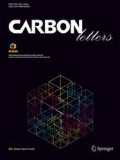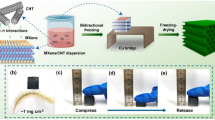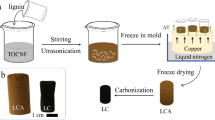Abstract
In recent years, special attention of energy researchers has been paid to application of polymer–carbon dots composite in energy storage systems. In this work, for the first time, we introduced a combination of polyaniline, carbon dots, polypyrrole and graphene as high performance supercapacitor. Synergistic effect of conductive polymers combined with specific properties of graphene and carbon dots improved the electrochemical performance of supercapacitor. Carbon dots was prepared from carrot juice hydrothermally as a biomass carbon source and polyaniline–carbon dots was synthesized via in-situ polymerization. Electrochemical performance of polyaniline with different carbon dots content was investigated and nanocomposite of polyaniline with 10 wt% carbon dots was selected to mix with polypyrrole–graphene to obtain a high potential window supercapacitor. The as-prepared composite was characterized by several spectroscopic and microscopic techniques. The electrochemical properties of this electrode were studied by cyclic voltammetry, galvanostatic charge/discharge, and electrochemical impedance spectroscopy techniques. A polyaniline–carbon dots (10%)/polypyrrole–graphene has showed the maximum specific capacitance of 396 F g−1. Value of specific capacity remained at 62% under the current density of 5 A g−1.








Similar content being viewed by others
References
Conway BE (1991) Transition from “supercapacitor” to “battery” behavior in electrochemical energy storage. J Electrochem Soc 138(6):1539–1548
Simon P, Gogotsi Y, Dunn B (2014) Where do batteries end and supercapacitors begin? Science 343(6176):1210–1211
Yu A, Chabot V, Zhang J (2013) Electrochemical supercapacitors for energy storage and delivery: fundamentals and applications. CRC Press, Boca Raton
Wang G, Zhang L, Zhang J (2012) A review of electrode materials for electrochemical supercapacitors. Chem Soc Rev 41(2):797–828
Conway BE (2013) Electrochemical supercapacitors: scientific fundamentals and technological applications. Springer Science & Business Media, Berlin
Ghadimi LS, Arsalani N, Tabrizi AG, Mohammadi A, Ahadzadeh I (2018) Novel nanocomposite of MnFe2O4 and nitrogen-doped carbon from polyaniline carbonization as electrode material for symmetric ultra-stable supercapacitor. Electrochim Acta 282:116–127
Namdarian A, Tabrizi AG, Maseleno A, Mohammadi A, Moosavifard SE (2018) One step synthesis of rGO-Ni3S2 nano-cubes composite for high-performance supercapacitor electrodes. Int J Hydrogen Energy 43(37):17780–17787
Kumar MS, Yasoda KY, Batabyal SK, Kothurkar NK (2018) Carbon–polyaniline nanocomposites as supercapacitor materials. Mater Res Express 5(4):045505
Magu TO, Agobi AU, Hitler L, Dass PM (2019) A review on conducting polymers-based composites for energy storage application. J Chem Rev 1(1):19–34 (pp. 1–77)
Wang Y, Yang J, Wang L, Du K, Yin Q, Yin Q (2017) Polypyrrole/graphene/polyaniline ternary nanocomposite with high thermoelectric power factor. ACS Appl Mater Interfaces 9(23):20124–20131
Zhang AQ, Zhang Y, Wang LZ, Li XF (2011) Electrosynthesis and capacitive performance of polyaniline–polypyrrole composite. Polym Compos 32(1):1–5
Snook GA, Kao P, Best AS (2011) Conducting-polymer-based supercapacitor devices and electrodes. J Power Sources 196(1):1–12
Liu C, Yu Z, Neff D, Zhamu A, Jang BZ (2010) Graphene-based supercapacitor with an ultrahigh energy density. Nano Lett 10(12):4863–4868
Raymundo-Piñero E, Cadek M, Béguin F (2009) Tuning carbon materials for supercapacitors by direct pyrolysis of seaweeds. Adv Func Mater 19(7):1032–1039
Lu H, Zhao X (2017) Biomass-derived carbon electrode materials for supercapacitors. Sustain Energy Fuels 1(6):1265–1281
Zhang JM, Hua Q, Li J, Yuan J, Peijs T, Dai Z, Zhang Y, Zheng Z, Zheng L, Tang J (2018) Cellulose-derived highly porous three-dimensional activated carbons for supercapacitors. ACS Omega 3(11):14933–14941
Wang Y, Hu A (2014) Carbon quantum dots: synthesis, properties and applications. J Mater Chem C 2(34):6921–6939
Lim SY, Shen W, Gao Z (2015) Carbon quantum dots and their applications. Chem Soc Rev 44(1):362–381
Georgakilas V, Perman JA, Tucek J, Zboril R (2015) Broad family of carbon nanoallotropes: classification, chemistry, and applications of fullerenes, carbon dots, nanotubes, graphene, nanodiamonds, and combined superstructures. Chem Rev 115(11):4744–4822
Dang Y-Q, Ren S-Z, Liu G, Cai J, Zhang Y, Qiu J (2016) Electrochemical and capacitive properties of carbon dots/reduced graphene oxide supercapacitors. Nanomaterials 6(11):212
De B, Kuila T, Kim NH, Lee JH (2017) Carbon dot stabilized copper sulphide nanoparticles decorated graphene oxide hydrogel for high performance asymmetric supercapacitor. Carbon 122:247–257
Kumar VB, Borenstein A, Markovsky B, Aurbach D, Gedanken A, Talianker M, Porat Z (2016) Activated carbon modified with carbon nanodots as novel electrode material for supercapacitors. J Phys Chem C 120(25):13406–13413
Devadas B, Imae T (2018) Effect of carbon dots on conducting polymers for energy storage applications. ACS Sustain Chem Eng 6(1):127–134
Hasani A, Gavgani JN, Pashaki RM, Baseghi S, Salehi A, Heo D, Kim SY, Mahyari M (2017) Poly(3,4 ethylenedioxythiophene): poly(styrenesulfonate)/iron(III) porphyrin supported on S and N Co-doped graphene quantum dots as a hole transport layer in polymer solar cells. Sci Adv Mater 9(9):1616–1625
Oskueyan G, Lakouraj MM, Mahyari M (2019) Nitrogen and sulfur Co-doped graphene quantum dots decorated CeO2 nanoparticles/polyaniline: as high efficient hybrid supercapacitor electrode materials. Electrochim Acta 299:125–131
Alam SN, Sharma N, Kumar L (2017) Synthesis of graphene oxide (GO) by modified hummers method and its thermal reduction to obtain reduced graphene oxide (rGO). Graphene 6(1):1–18
Liu Y, Liu Y, Park M, Park S-J, Zhang Y, Akanda MR, Park B-Y, Kim HY (2017) Green synthesis of fluorescent carbon dots from carrot juice for in vitro cellular imaging. Carbon Lett 21:61–67
Tharani S, Vinayagam S (2015) Synthesis of novel cerium doped polyaniline multiwalled carbon nanotubes and their optical and electrochemical properties for supercapacitor applications. Int J Adv Res 3:810–822
Zhang K, Zhang LL, Zhao X, Wu J (2010) Graphene/polyaniline nanofiber composites as supercapacitor electrodes. Chem Mater 22(4):1392–1401
Hsu F-H, Wu T-M (2012) In situ synthesis and characterization of conductive polypyrrole/graphene composites with improved solubility and conductivity. Synth Met 162(7–8):682–687
Yang H, Wang N, Xu Q, Chen Z, Ren Y, Razal JM, Chen J (2014) Fabrication of graphene foam supported carbon nanotube/polyaniline hybrids for high-performance supercapacitor applications. 2D Materials 1(3):034002
Jang J, Yang H (2000) The effect of surface treatment on the performance improvement of carbon fiber/polybenzoxazine composites. J Mater Sci 35(9):2297–2303
Sawangphruk M, Suksomboon M, Kongsupornsak K, Khuntilo J, Srimuk P, Sanguansak Y, Klunbud P, Suktha P, Chiochan P (2013) High-performance supercapacitors based on silver nanoparticle–polyaniline–graphene nanocomposites coated on flexible carbon fiber paper. J Mater Chem A 1(34):9630–9636
Wang D, Wang Z, Zhan Q, Pu Y, Wang J-X, Foster NR, Dai L (2017) Facile and scalable preparation of fluorescent carbon dots for multifunctional applications. Engineering 3(3):402–408
Kundu A, Shit A, Nandi S (2017) Carbon dot assisted synthesis of nanostructured polyaniline for dye sensitized solar cells. Energy Fuels 31(7):7364–7371
De Oliveira HP, Sydlik SA, Swager TM (2013) Supercapacitors from free-standing polypyrrole/graphene nanocomposites. J Phys Chem C 117(20):10270–10276
Li H, Kang Z, Liu Y, Lee S-T (2012) Carbon nanodots: synthesis, properties and applications. J Mater Chem 22(46):24230–24253
Tian J, Yang Z, Yin Z, Ye Z, Wang J, Cui C, Qian W (2019) Perspective to the potential use of graphene in Li-ion battery and supercapacitor. Chem Rec 19(7):1256–1262
Bora C, Dolui SK (2014) Interfacial synthesis of polypyrrole/graphene composites and investigation of their optical, electrical and electrochemical properties. Polym Int 63(8):1439–1446
Sciortino A, Cannizzo A, Messina F (2018) Carbon nanodots: a review—from the current understanding of the fundamental photophysics to the full control of the optical response. C J Carbon Res 4(4):67
Baweja H, Jeet K (2019) Economical and green synthesis of graphene and carbon quantum dots from agricultural waste. Mater Res Express 6(8):0850–0858
Pol VG, Thackeray MM (2011) Spherical carbon particles and carbon nanotubes prepared by autogenic reactions: evaluation as anodes in lithium electrochemical cells. Energy Environ Sci 4(5):1904–1912
Lee K, Cho S, Kim M, Kim J, Ryu J, Shin K-Y, Jang J (2015) Highly porous nanostructured polyaniline/carbon nanodots as efficient counter electrodes for Pt-free dye-sensitized solar cells. J Mater Chem A 3(37):19018–19026
Liu W-f, Yang Y-z, Liu X-g, Xu B-s (2016) Preparation and electrochemical performance of a polyaniline–carbon microsphere hybrid as a supercapacitor electrode. New Carbon Mater 31(6):594–599
Feng J, Zhang Q, Wang J, Yang H, Xu H, Yan W (2015) Application of chemically synthesized polypyrrole with hydro-sponge characteristic as electrode in water desalination. Rsc Advances 5(88):71593–71600
Mondal S, Rana U, Malik S (2015) Graphene quantum dot-doped polyaniline nanofiber as high performance supercapacitor electrode materials. Chem Commun 51(62):12365–12368
Chen J, Song J, Feng X (2017) Facile synthesis of graphene/polyaniline composite hydrogel for high-performance supercapacitor. Polym Bull 74(1):27–37
Liu Z, Chen W, Fan X, Yu J, Zhao Y (2016) Preparation of 3D MnO2/Polyaniline/Graphene Hybrid Material via Interfacial Polymerization as High-Performance Supercapacitor Electrode. Chin J Chem 34(8):839–846
Sk MM, Yue CY, Jena RK (2014) Synthesis of graphene/vitamin C template-controlled polyaniline nanotubes composite for high performance supercapacitor electrode. Polymer 55(3):798–805
Nguyen LH, Gomes VG (2019) High efficiency supercapacitor derived from biomass based carbon dots and reduced graphene oxide composite. J Electroanal Chem 832:87–96
Acknowledgements
The financial support provided by the Iran National Science Foundation (INSF) is gratefully.
Author information
Authors and Affiliations
Corresponding author
Additional information
Publisher's Note
Springer Nature remains neutral with regard to jurisdictional claims in published maps and institutional affiliations.
Rights and permissions
About this article
Cite this article
Oskueyan, G., Mansour Lakouraj, M. & Mahyari, M. Fabrication of polyaniline–carrot derived carbon dots/polypyrrole–graphene nanocomposite for wide potential window supercapacitor. Carbon Lett. 31, 269–276 (2021). https://doi.org/10.1007/s42823-020-00162-w
Received:
Revised:
Accepted:
Published:
Issue Date:
DOI: https://doi.org/10.1007/s42823-020-00162-w




